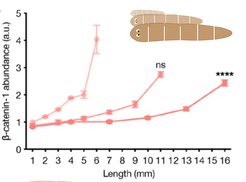Regulation of Body Size

Body size fluctuations of an S. mediterranea individual, live-imaged during a feeding time course.
An intriguing feature of planarians is their lack of a fixed body size. A small tissue piece cut from a large worm regenerates into a small worm. When fed, small worms grow again into big worms, but when starving, they literally reverse the growth process and shrink. As a result, planarian body sizes fluctuate continuously as a function of feeding rate and food quality, for example between ~ 0.5 and >25 mm body length in case of the model species S. mediterranea. In addition, the maximal body size differs tremendously between planarian species, ranging from barely mm-length marine planarians to the “shoe-sole sized planarians of lake Baikal or even meter-long land planarians in Japan.

Scaling of the b-Catenin gradient in differently sized S. mediterranea.
So far, we could confirm that planarians grow and de-grow by a change in cell numbers, not cell size and that both the growth and de-growth rates are strongly size-dependent (Thommen et al., 2019). We further found that planarians follow the broadly observed ¾ scale exponent of metabolic rate versus body mass, which, intriguingly, reflects a size-dependent increase in the mass per cell due to size-dependent lipid storage (Thommen et al., 2019). Ongoing projects study the size-dependence of planarian energy metabolism and other size-dependent aspects of planarian physiology. Additional interest areas include the mechanistic basis of signaling pattern scaling and the comparative analysis of growth/degrowth dynamics in our species collection. And we are on the hunt for the “dinosaurs” in planarian phylogeny, the giant flatworms of lake Baikal.
Questions we are interested in
The availability of body size as an experimental variable makes planarians a perfect system for probing the many fundamental unknowns of size in biology. For example,

Metabolic scaling- planarians display a ¾ exponent of metabolic rate scaling with mass, as broadly seen across animal phylogeny. Image taken from (Thommen et al., 2019).
- What mediates the coordination of cell addition and loss rates across all tissues during organismal growth or degrowth?
- What are the size sensing mechanisms that determine constituent cell numbers in biological systems?
- What mediates body size encoding in animal genomes?
- What is the mechanistic origin of the ¾-law scaling of metabolic rate with the mass of biological systems?


